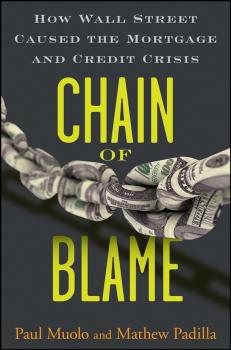ТОП просматриваемых книг сайта:
Paul Muolo
Список книг автора Paul MuoloАннотация
An updated and revised look at the truth behind America's housing and mortgage bubbles In the summer of 2007, the subprime empire that Wall Street had built all came crashing down. On average, fifty lenders a month were going bust-and the people responsible for the crisis included not just unregulated loan brokers and con artists, but also investment bankers and home loan institutions traditionally perceived as completely trustworthy. Chain of Blame chronicles this incredible disaster, with a specific focus on the players who participated in such a fundamentally flawed fiasco. In it, authors Paul Muolo and Mathew Padilla reveal the truth behind how this crisis occurred, including what individuals and institutions were doing during this critical time, and who is ultimately responsible for what happened. Discusses the latest revelations in the housing and mortgage crisis, including the SEC's charging of Angelo Mozilo Two well-regarded financial journalists familiar with the events that have taken place chronicle the crisis in detail, showing what happened as well as what lies ahead Discusses how the world's largest investment banks, homeowners, lenders, credit rating agencies, underwriters, and investors all became entangled in the subprime mess Intriguing and informative, Chain of Blame is a compelling story of greed and avarice, one in which many are responsible, but few are willing to admit their mistakes.
$700 Billion Bailout. The Emergency Economic Stabilization Act and What It Means to You, Your Money, Your Mortgage and Your Taxes - Paul Muolo
Аннотация
The book is an analysis of the controversial Emergency Economic Stabilization Act and explains in easy to understand language what the bailout bill means for individuals. $700 Billion Bailout answers questions such as: What does the bill say, exactly? Who is making decisions about how the $700 billion will be spent, and what does it mean now that the government is investing directly in our banks? Who’s footing the bill? What is the impact on homeowners, businesses, retirement, and taxes? Where do I put my money in the meantime? Veteran reporter Paul Muolo shows both the challenges and opportunities of the credit crisis and proposed bailout, including its impact on: Mortgages: While rates may be lower, there will be more fees imposed on mortgages. Lenders will be far more cautious in lending, and people who cannot meet their mortgages are likely to lose these homes. This may create a “contrarian” plays in foreclosures and vacation homes.. Stocks and Other Investments: Is now the time to get into the stock market or is it safer to stick with CDs, bonds, and gold? Taxes: With the tax breaks, there will be less tax revenue leading to a huge shortfall to the government over the next few years. He will offer insight into these areas and many others, including how the structure of the bailout bill allows for unprecedented authority that has altered the financial landscape, perhaps permanently. Will the plan work, and how we can prevent this from happening again remains to be seen, but with $700 Billion Bailout Paul Muolo gives us a critical tool for deciphering perhaps the most sweeping piece of legislation since the Patriot Act.


